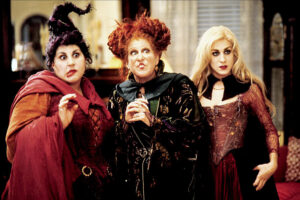The trees are changing color, there is a slight breeze as you feign sanity weeks into your perpetual midterm season, and you are somehow sweating because you didn’t realize it could still be eighty degrees in October. Happy Halloween from the Hilltop!
Hoya or not, college students across the nation are scrambling to finalize their multi-weekend fashion show, stopping at no end to develop their historical renditions and unique takes on the latest trends with the most perfect pieces, courtesy of Amazon.
To be honest, my catalog of Halloween attire is pathetic. My past costumes were infrequently original—except the time I dressed up as Ketchup, that was awesome—and more often than not hand-me-downs from older friends or pulled directly from my closet. But one fateful day in a pop-up Spirit Halloween, which was naturally in an abandoned building, I found my true Halloween alter ego: the ever-classic witch. From second grade and well into my teenage years, the hat and accompanying all black ensemble solved my aversion to Halloween costume plotting.
While perhaps lame, there is something to learn from my faithful childhood costume, especially amidst the surge of frankly concerning Halloween practices. Since this summer, my TikTok feed has been a constant stream of costume inspiration. I am critically behind on figuring out the perfect rendition of, who knows honestly, I still need to secure a group of at least half-dozen friends, as well as a boyfriend, and should probably just go ahead and bleach my hair if I want to be the most accurate Sabrina Carpenter possible. Doom-scrolling through ‘it girl’ costume recommendations frankly drains the joy out of the otherwise festive holiday. But there’s a more alarming issue at hand.
As we debate whether “Halloweekend” should be the weekend before or after the 31st (after, obviously), we should rather engage in a more pertinent discussion of the environmental implications of how we celebrate Halloween.
Let’s be honest: the only thing scarier than your recreation of Wednesday Adams is that it could take over 200 years for that very costume to decompose.
Costumes are rarely built to last, made from the cheapest (and most uncomfortable) fabrics. 83% of costumes use non-recyclable plastic. The fashion industry as a whole is a major source of the climate crisis, as 11.3 million tons of textile end up in landfills. Waste management systems are unable to regulate the incredible amount of trash sent to landfills. Americans are expected to spend a record $13.1 billion on costumes this year—The Hallmark-ification of the holiday has led to an ever-growing demand for costumes at an unsustainable rate.
Beyond costumes, accompanying accessories, candy, and decorations are mostly plastic and often quickly discarded. Last year, for one, Americans bought an estimated 600 million pounds of candy, with trash that is often impossible to recycle. While overconsumption is not an exclusively October problem, Halloween is a major source of waste.
This is not to say that we are helpless in the face of fast fashion. And you are not immoral for wanting to participate in a group costume with friends while avoiding the high cost of mainstream sustainable brands.
In-between the aforementioned costume recommendation videos, there is a strong counter-niche of environmentally aware content creators. In place of Shein hauls are thrift store guide videos, how-to videos for clothing repair, and recommendations for costumes that viewers can make with clothing they already have. Looking into your own closet can open a world of possibilities: that button-up you had to buy for networking would make the perfect Blair Waldorf from Gossip Girl (2007), or find a tie and be Men in Black (1997). A black or red dress and a headband, with a bit of creative felt work, and you can quickly become a black cat or devil. While perhaps basic, I’m sure there are endless possibilities from your specific collection.
This year, as Georgetown houses are adorned with funky-looking pumpkins and the girl next to you in class is showing off her Amazon cart full of costumes, take a moment. Look in your closet, ask your friends if they have what you need, and, if it comes to it, look for second-hand costumes or pieces that you know you could re-wear. Or, inspired by the youthful version of me, buy a single prop and commit to it for the foreseeable future. After all, witches are timeless.





